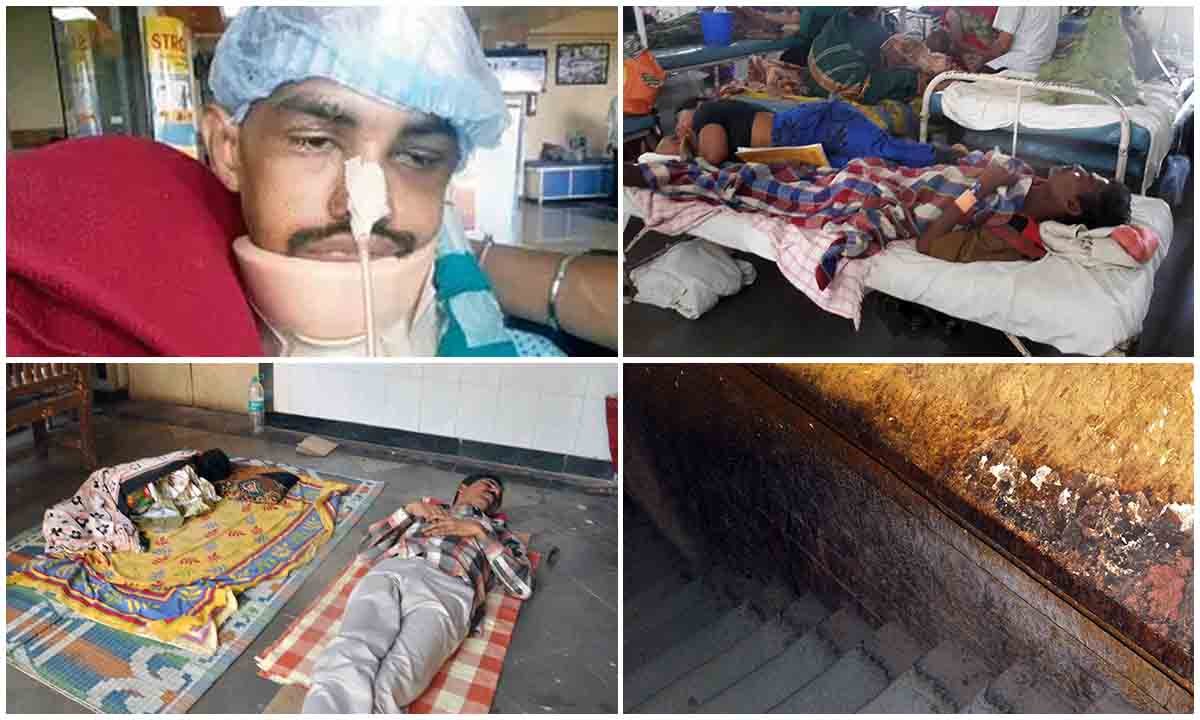
Most of the government hospitals in Mumbai are in horrible conditions. Most of the time, Rajawadi, KEM, Bhagwati and Shatabdi Hospital hit the headlines for the wrong reasons. Well, mostly only those patients who choose to go to government hospitals, who cannot afford private healthcare. Patients are treated like objects. Overcrowded wards, dirty unhygienic toilets, stinking corridors, worst food and substandard medical facilities are common factors in all these government and BMC-run hospitals.
Recently monkey menace at KEM hospital has created panic in patients. They found one monkey attacking patients, visitors and staff, taking away their bags. A nurse said there have been three cases of monkey bites within the premises. Those bitten or scratched now have to take the anti-rabies vaccine. While dogs, cats and mice are often found on the hospital premises, this time one monkey has made the hospital its adventure trip. This time it was just a monkey but there are bizarre incidents of rats nibbling on the eye of a patient in the ICU of Mumbai’s Rajawadi hospital.
The patient, Shrinivas Nagesh Yallapa, was admitted in a serious condition and was on ventilator support. Rats nibbled his eye and hospital management was in denial mode. Rajawadi hospital has been in a state of neglect for a long time. Rajawadi is one of the biggest hospitals in the eastern suburbs; the BMC has not been sanctioning enough funds to maintain it. The ICU is not secured enough, there are many rats around and the rats enter when someone opens the ICU door. There are colonies of rats in the ICU ward. The whole day they remain quiet and during night hours they nibble on all that is available to them including patients.
Shatabdi Hospital has gone to the rats. The patients get brutally attacked by rats. – One victim’s eye was nibbled at, while the other woman’s toe was gnawed on by the rodents. All the hospital management has done is to place trap cages around the premises, while the rodents continue to have the run of the place. Even today, no authorities could control the rat population and its attack. There is no vigilance, no management in place, no one is here to see the inconvenience faced by poor people.
Whenever a patient arrives in an emergency department, he /she first encounters the EMO room, whose job is to assign a patient either outpatient treatment or if severe, he/she is required to go to a specific emergency room (e.g., Surgery, medicine, ortho emergency etc) During the way, sometimes the stretcher is missing and the unconscious patient has to wait until it arrives and sometimes the attendant goes missing. (As there are only 2–3 stretchers which fall short when patient load increases).
Senior doctors are only available three times a day (morning rounds, afternoon and evening rounds). The junior residents are mostly irresponsible and insensitive towards their patients because they are also equally irritated with the circumstances. The AC in the operation theatre was mostly in non-working conditions, and we can see sweat dribbling from the resident’s forehead directly on the patient getting operated on. Sometimes operation theatre lights are not working, most of the time doctors are busy chatting with each other during surgery.
Ventilators in the paediatric department always have problems. Nurses are rude and insensitive towards women patients who deliver babies. Lack of toilet facilities, no attendants, and no doctors are available in time. The conditions of these hospitals are very inhumane. These human lives have no value and it does not give them basic dignity. The corrupt staff, ward boys and girls are another nuisance. Governments come and go, but the conditions of these hospitals remain the same. There are several reasons for government-funded hospitals in India being filthy. The cleaning crew is usually lazy and unmotivated. This usually happens with regular government employees, who are mostly disinclined to work. Government hospitals see a heavier footfall than private ones. The crowd outside our OPDs resembles a protest gathering on most days. People are spitting gutka openly on the premises. I have seen small children defecating and urinating openly near the patient queues despite lavatory facilities being available for patients but those lavatories are just hell dirty.
Most of public hospitals are grossly underfunded. Hence, these hospitals do not spend on services which are perceptibly more essential to patient care (e.g., drug and instrument supplies) and sanitation. People don’t believe in the ownership of public facilities like they do in developed countries. Mumbai’s busiest public medical centre, Sion Hospital, stands as a defining landmark on the southeast border of one of the city’s most well-known slums. The medical centre, Sion Hospital, opened in 1947 and has had to deal with unprecedented and unexpected growth and a range of health issues that accompany the extremely poor living conditions of local residents. It wasn’t until 1976 that the government began providing water and electricity services, and even today, those services don’t reach all residents. Over the years, cramped living quarters, lack of sanitation, trash issues and unsafe water have created serious health ramifications for the community. The hospital’s growth from a 50-bed facility in its infancy in the 1950s to a 1,400-bed facility today tells a story about its surrounding area that decades of census neglect have failed to record. The walls are so dirty and spider webs are everywhere. A few tube lights and a few fans are in good condition, but a few fans are off because of some technical problems.
You visit any government hospital in Mumbai; the conditions are similar everywhere. The population is on the rise, medical facilities are inadequate. Mumbai has many challenges in taking care of the enormous population. Most government hospitals share the additional burden of jail inmates’ check-ups, post-mortems and health investigations. Staff is not sufficient, doctors lack the will, and the government lacks commitment to the people. India might progress on the paper but ground realities are not going to change ever.

